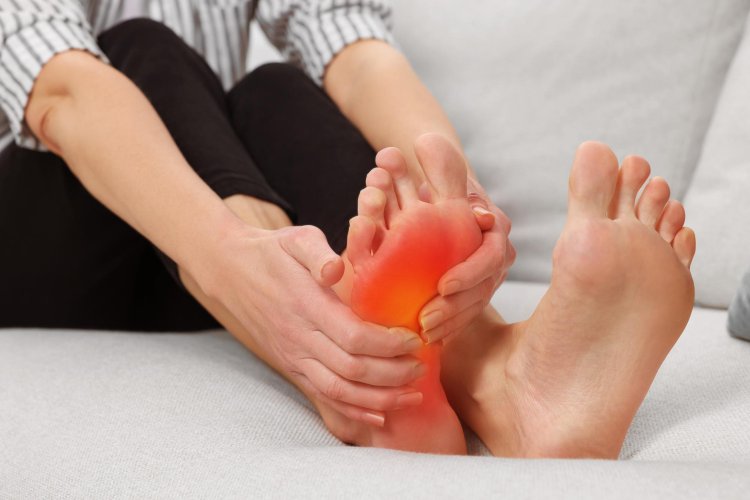On Your Feet Again: The Ultimate Plantar Fasciitis Survival Guide
Plantar fasciitis is a common foot condition that affects millions of people worldwide. It can cause significant discomfort and impact daily activities, but with proper understanding and management, individuals can find relief and improve their quality of life. In this article, we will delve into the causes, symptoms, diagnosis, treatment options, and preventive measures for plantar fasciitis.

What is Plantar Fasciitis?
Plantar fasciitis is a condition characterized by inflammation of the plantar fascia, a thick band of tissue that runs along the bottom of the foot, connecting the heel bone to the toes. The plantar fascia plays a crucial role in supporting the arch of the foot and absorbing shock during activities like walking, running, and jumping.
Causes of Plantar Fasciitis:
Several factors can contribute to the development of plantar fasciitis, including:
- Overuse: Repetitive strain on the plantar fascia, such as excessive walking, running, or standing, can lead to micro-tears and inflammation.
- Foot Structure: Individuals with flat feet or high arches may be more prone to plantar fasciitis due to abnormal foot mechanics.
- Obesity: Excess body weight can increase the load placed on the plantar fascia, leading to inflammation and pain.
- Poor Footwear: Wearing shoes with inadequate arch support or cushioning can strain the plantar fascia and contribute to the development of plantar fasciitis.
- Tight Muscles: Tight calf muscles or Achilles tendon can place additional stress on the plantar fascia, increasing the risk of injury.
Symptoms of Plantar Fasciitis:
The most common symptom of plantar fasciitis is heel pain, typically located on the bottom of the foot near the heel bone. The pain is often described as sharp or stabbing and is usually most severe with the first steps in the morning or after prolonged periods of rest. Other symptoms may include:
- Pain that improves with activity but worsens with prolonged standing or walking.
- Stiffness and discomfort in the bottom of the foot, especially after sitting for extended periods.
- Tenderness or swelling along the arch of the foot.
Diagnosis of Plantar Fasciitis:
Diagnosing plantar fasciitis typically involves a thorough medical history and physical examination. Your healthcare provider may inquire about your symptoms, activity level, footwear, and any previous injuries. They may also perform specific tests to assess the range of motion in your foot and identify areas of tenderness. In some cases, imaging tests such as X-rays or MRI may be ordered to rule out other possible causes of heel pain, such as stress fractures or heel spurs.
Treatment Options:
Treatment for plantar fasciitis aims to reduce pain and inflammation, promote healing, and prevent recurrence. Depending on the severity of the condition, treatment options may include:
- Rest: Avoiding activities that exacerbate symptoms and giving the foot time to heal.
- Ice Therapy: Applying ice packs to the affected area several times a day to reduce pain and inflammation.
- Stretching Exercises: Performing gentle stretching exercises for the calf muscles, Achilles tendon, and plantar fascia to improve flexibility and reduce tension.
- Orthotic Devices: Using shoe inserts or orthotic devices to provide support and cushioning for the arch of the foot.
- Physical Therapy: Working with a physical therapist to develop a tailored exercise program to strengthen the muscles of the foot and ankle and improve overall biomechanics.
- Medications: Over-the-counter pain relievers such as ibuprofen or naproxen may help alleviate pain and reduce inflammation.
- Night Splints: Wearing a night splint to keep the foot in a dorsiflexed position overnight, stretching the plantar fascia and Achilles tendon.
Preventive Measures:
Preventing plantar fasciitis involves taking proactive steps to reduce the risk of injury and promote foot health. Some preventive measures include:
- Wearing supportive footwear with adequate arch support and cushioning.
- Avoiding walking barefoot, especially on hard surfaces.
- Gradually increasing the intensity and duration of physical activity to prevent overuse injuries.
- Maintaining a healthy weight through a balanced diet and regular exercise to reduce stress on the feet and lower limbs.
- Stretching regularly to maintain flexibility in the calf muscles, Achilles tendon, and plantar fascia.
Living with Plantar Fasciitis:
Living with plantar fasciitis can be challenging, but with proper management and self-care, many individuals can find relief from their symptoms and continue to participate in their favorite activities. It's essential to listen to your body, avoid activities that aggravate your symptoms, and seek appropriate medical treatment if needed.
In conclusion, Plantar fasciitis is a common foot condition that can cause significant discomfort and impact daily functioning. By understanding the causes, symptoms, diagnosis, treatment options, and preventive measures for plantar fasciitis, individuals can take proactive steps to manage their symptoms, reduce the risk of recurrence, and improve their overall foot health. If you are experiencing persistent heel pain or suspect you may have plantar fasciitis, consult with a healthcare professional for proper evaluation and personalized treatment recommendations.
Disclaimer:
The information provided in this article is for educational purposes only and should not be considered medical advice. If you have any health concerns or are experiencing symptoms, it is important to consult with a healthcare professional, such as a doctor or clinic, for proper diagnosis and treatment. Always seek the advice of your doctor or other qualified health provider with any questions you may have regarding a medical condition. Do not disregard professional medical advice or delay in seeking it because of something you have read in this article.
#PlantarFasciitis #FootHealth #PainRelief #PreventionTips
What's Your Reaction?





















